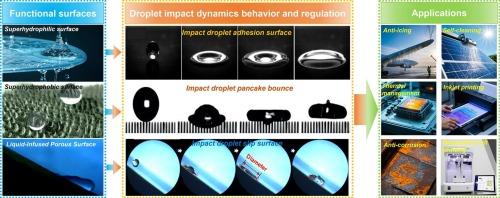Recent progress in droplet dynamics on advanced micro/nano-structured surfaces: Theory, experiments and applications
IF 9.8
1区 工程技术
Q1 ENGINEERING, CHEMICAL
引用次数: 0
Abstract
The dynamic behaviors of droplets on complex structured surfaces widely exists in nature and industrial applications. With the rapid development of interfacial materials and micro/nano-fabrication technologies, various advanced micro/nanostructured surfaces are fabricated to modulate droplet dynamics. This review firstly provides a comprehensive overview of the fabrication methods of advanced micro/nano-structured surfaces including superhydrophilic, superhydrophobic and lubricant-injected surfaces, and highlights the advantages and disadvantages. Secondly, the droplet dynamic behaviors (droplet rotation, splitting and directional migration) on advanced micro/nanostructured surfaces are discussed. Thirdly, applications of advanced functional surfaces, including anti-icing, self-cleaning, anti-corrosion, thermal management, and photothermal interface evaporation, are described in detail. Finally, challenges and directions for future research are concluded and outlooked. Existing research lacks a unified theoretical framework to integrate multi-scale force and thermodynamic coupling, and issues of scalable fabrication, durability, environmental sustainability, and multi-physics field coupling need to be addressed. Subsequent research directions need to construct cross-scale prediction models and combine them with multi-physics simulations to promote machine learning and interdisciplinary integration for precise regulation of droplet dynamics and practical applications on functional surfaces. This work provides important insights for advancing the application of droplet modulation technology in anti-icing, self-cleaning, anti-corrosion, thermal management, and seawater desalination.

先进微纳米结构表面液滴动力学研究进展:理论、实验与应用
液滴在复杂结构表面上的动力学行为广泛存在于自然界和工业应用中。随着界面材料和微纳米制造技术的快速发展,各种先进的微纳米结构表面被制造出来以调节液滴的动力学。本文首先综述了超亲水表面、超疏水表面和润滑油注入表面等先进微纳米结构表面的制备方法,并分析了其优缺点。其次,讨论了先进微纳米结构表面上液滴的动态行为(旋转、分裂和定向迁移)。第三,详细介绍了先进功能表面的应用,包括防冰、自清洁、防腐、热管理和光热界面蒸发。最后,对未来研究面临的挑战和方向进行了总结和展望。现有研究缺乏统一的理论框架来整合多尺度力和热力学耦合,需要解决可扩展制造、耐用性、环境可持续性和多物理场耦合等问题。后续的研究方向需要构建跨尺度的预测模型,并将其与多物理场模拟相结合,推动机器学习和跨学科的融合,以实现液滴动力学的精确调控和在功能表面的实际应用。该工作为推进液滴调制技术在防冰、自清洁、防腐、热管理和海水淡化等方面的应用提供了重要的见解。
本文章由计算机程序翻译,如有差异,请以英文原文为准。
求助全文
约1分钟内获得全文
求助全文
来源期刊

Desalination
工程技术-工程:化工
CiteScore
14.60
自引率
20.20%
发文量
619
审稿时长
41 days
期刊介绍:
Desalination is a scholarly journal that focuses on the field of desalination materials, processes, and associated technologies. It encompasses a wide range of disciplines and aims to publish exceptional papers in this area.
The journal invites submissions that explicitly revolve around water desalting and its applications to various sources such as seawater, groundwater, and wastewater. It particularly encourages research on diverse desalination methods including thermal, membrane, sorption, and hybrid processes.
By providing a platform for innovative studies, Desalination aims to advance the understanding and development of desalination technologies, promoting sustainable solutions for water scarcity challenges.
 求助内容:
求助内容: 应助结果提醒方式:
应助结果提醒方式:


